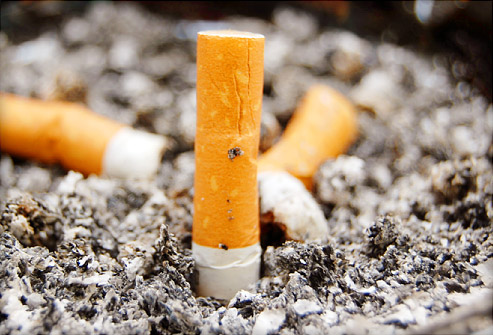COPD: How to Quit Smoking
[ad_1]
You breathe in lots of toxic chemicals when you smoke tobacco. Anyone who wants to get healthier should quit. But if you have COPD, it’s even more important to kick the habit.
“If you continue to smoke, it’s going to worsen your lungs at a faster rate than if you quit,” says Sue Galanes, a nurse practitioner at Northwestern Medicine Central DuPage Hospital. It can also put you more at risk for lung cancer, heart disease, stroke, and a host of other health problems.
It can be really hard to quit smoking, as you probably already know — especially if you’ve tried before. Here are some tips that might help you put down cigarettes for good.
Get Prepared
Even if you have COPD or other lung problems, “knowing that you should quit and being ready to quit are two different things,” says Galanes, who helps people with lung diseases stop smoking.
To boost your success, here’s some of her advice:
Make a list. Write down why you want to stop smoking. And be prepared to challenge all the excuses you’ve used in the past. That can “get your brain ready to actually proceed with quitting,” Galanes says.
Change your behavior. You may feel a strong desire to smoke when you do certain things. These are known as your triggers. It can be helpful to break these links ahead of time.
For example, if you always have a cigarette with your morning coffee, start to separate the two. “You can have the cigarette or the coffee. You can’t have them together,” Galanes says. “It’ll make a huge difference when it comes to your quit date. So that when you have that cup of coffee, you don’t have that urge that you have to have a cigarette.”
As you’re kicking the habit, Galanes also suggests only smoking outdoors. It makes it more inconvenient to light up. This extra step might help lessen the number of cigarettes you have each day while you’re working your way towards zero cigarettes every day.
Find a substitute. “A lot of people have smoked for more than 30 years,” Galanes says. “And besides the addictive component of smoking, there’s the habit.” You can have a kind of withdrawal from this “hand-to-mouth” routine, she says. When you get antsy, swap your cigarettes for things such as:
-
Sugar-free suckers -
Carrots or celery sticks - Straws cut into thirds
- Coffee stirrers
- Toothpicks
Continued
Know Your Choices
The more you do to quit, the better your chances of success, says Galanes. She lets her patients know about behavioral therapy and lots of other quit-smoking aids, such as:
Nicotine replacement therapy (NRT). You can go through some uncomfortable physical withdrawal effects when you give up nicotine. That’s because have to adjust to a new life without the drug in your system.
NRT can give you nicotine without the harmful effects of tobacco smoke. And studies show your chances of quitting go way up if you use NRT.
You’ll start NRT on your quit date, Galanes says. Talk to your doctor about the pros and cons of each type. Over-the-counter choices include gum, patches, and lozenges. You’ll need a prescription for NRT sprays or inhalers.
Prescription drugs. These work in a different way than NRT. A drug called varenicline (Chantix) changes how your body responds to the “rewards” of nicotine. An antidepressant called bupropion (Zyban) is helpful for some people, though experts aren’t sure why.
You’ll start these about 1 week before you quit, Galanes says.
Quit-smoking apps. You can use your smartphone to set a quit date, log your smoking triggers, and manage your cravings, among other things. “We don’t recommend one app over another,” Galanes says. “But we do give a list of what’s available.”
You can go to Smokefree.gov for some free options.
Find Healthy Ways to Unwind
If smoking was something you did when you were stressed out, you may feel more stressed at first when you give up tobacco because you closed the door on that unhealthy way to handle stress.
But you can find other ways to relax.
These techniques may help you deal with cravings and improve your mood. Galanes suggests:
If you’re new to exercise, Galanes suggests you start walking before you quit smoking. Just don’t take your cigarettes with you, she says. Joining a quit-smoking program that includes support from other people can also help.
If you have conditions like depression or anxiety, line up extra help. Your doctor can refer you to a psychologist or psychiatrist. Those are trained professionals who’ll help you find the best ways to manage your mental health.
Continued
Do Less Harm
When it comes to cigarettes, the smoking part is worse for your COPD than nicotine, says Benjamin J. Seides, MD, director of interventional pulmonology at Northwestern Medicine Central DuPage Hospital. That’s why short- and long-term NRT is a key part of his quit-smoking approach.
“Everyone wants to be clean and free [of nicotine]. But that’s not always a realistic goal,” Seides says. “We may not get you all the way to somebody who doesn’t have any relationship to nicotine. But if I can get the cigarettes out of your mouth, then I’m happy.”
Keep Trying
You may not be able to give up smoking on your first go. But don’t give up. The more you keep trying, the more likely you are to be successful.
Always have a plan for how you’ll get back on track if you relapse. “There’s a process to quitting,” Galanes says. “You may slip up and have one, but you still need to stay on board for quitting.”
[ad_2]
Source link




